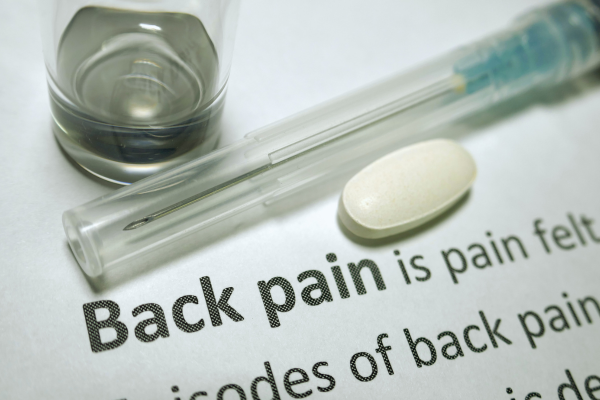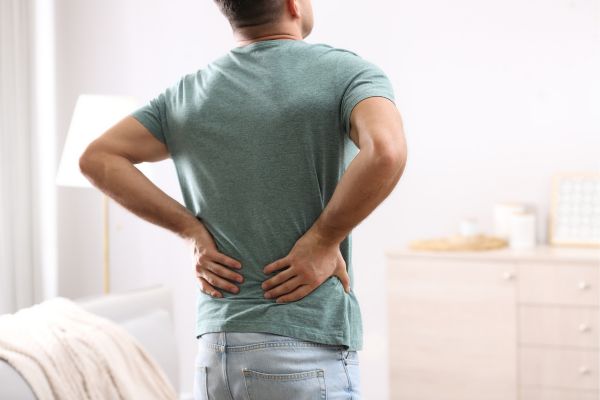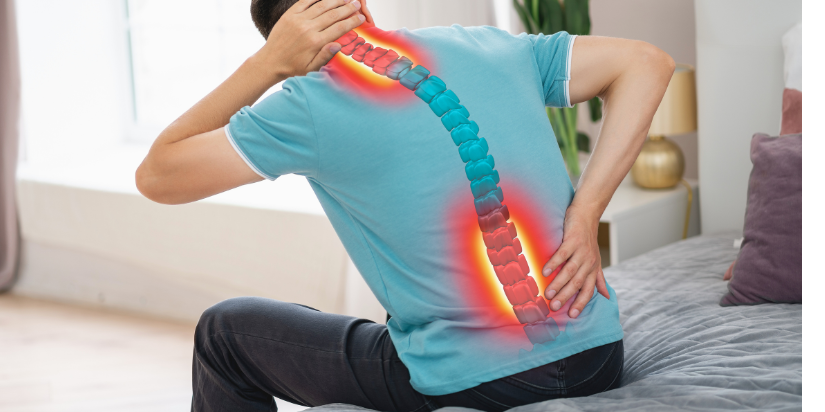If you’re like 80% of Americans, you’ve probably experienced or will experience pain in your lower – especially as you get older. Maybe you suffered an injury at work, or perhaps you were in an auto accident. You may have developed a painful lower back condition and can’t pinpoint any specific cause at all. No matter the reason, you want answers – and, more importantly, relief from your pain. Do you want the best treatment option? It just may be seeing a chiropractor for back pain treatment.
Let’s help you find answers to your back pain questions by discussing the prevalence, causes, and treatments for back pain, including chiropractic care and back surgery. Before we do, learn more about the effective back pain chiropractic treatment offered at Algonquin Chiropractic Center by clicking the button below.
How Widespread is Back Pain?
When you’re suffering from back pain, it’s easy to feel like you’re alone and nobody understands what you’re going through. Back pain in our society is often viewed as a minor inconvenience that you should “push through.” Friends, family, employers and even doctors may downplay how painful and debilitating this condition can be or even question if you’re faking it.
However, back pain is a real and serious condition, and you’re far from being alone. In fact, in 2010, low back pain was the most common cause of disability in the world, affecting nearly one in every ten people. It’s the leading global cause of “years lived with disability,” or YLD.
Here in the U.S., 31 million Americans suffer from back pain at any given time. It’s also the number one cause of lost workdays and accounts for about a third of all work-related disabilities.
As a result, back pain accounts for the third largest share of U.S. healthcare spending on any condition. We spend an estimated $87.6 to $100 billion per year treating this condition—the only conditions that cost us more are diabetes and ischemic heart disease.
So, if you’re living with low back pain, you’re not alone—millions of people’s lives are affected by this condition. Luckily, plenty of people and resources are dedicated to figuring out what causes it and how to treat it.
What Causes Lower Back Pain?
Technically, back pain isn’t a condition. It’s a symptom that can be caused by a variety of underlying conditions.
Conditions that can result in back pain include:
- Degenerative Disc Disease (DDD)
- Spinal Stenosis
- Osteoarthritis
- Strains and Sprains
- Herniated Disc
- Spondylolisthesis
- Fractures and Dislocations
- Facet Syndrome
- Spinal Arthritis
- And More
Many of these are progressive conditions that build up over time as your body accumulates wear and tear. Others can be caused by traumatic events like car accidents, sports injuries, falls or even just picking up heavy objects the wrong way. Often, patients aren’t even aware of what may have caused their back pain.
Our job at Algonquin Chiropractic is to find the underlying CAUSE of your pain and treat the cause, not cover it up with medications that have side effects and are potentially addictive.

How Can I Relieve My Low Back Pain?
Pain management and treatment are two components of effectively minimizing lower back pain. Management includes all the things you can do to reduce the amount of pain you feel. Treatment includes professional procedures to address the root problem and improve your condition long-term.
What Home Therapies Are There for Managing Back Pain?
Depending on which condition is causing your lower back pain, various home therapies, exercises and lifestyle changes can help keep it from flaring as badly. These differ depending on if the cause is a muscular issue, a degenerative disease, a spinal injury, etc. You should consult with an experienced chiropractor for back pain to develop a pain management plan that’s right for you.
Some examples of home therapies include:
- Avoid Bed Rest—Your first instinct may be to stay off your feet, but this will only weaken your muscles and potentially intensify your pain.
- Avoid prolonged Sitting—This increases pressure on the discs in your lower spine, which is exactly what you don’t
- Cold Therapy—Apply a cold pack to your back for 15 minutes every one to two hours. You could use an ice massage, a cold pack, a baggie of ice cubes or even a pack of frozen vegetables.
- Topical Analgesics—Apply a brand like Cryoderm, Icy Hot or Bio Freeze to the area that hurts. Applying these products should take the edge off while you’re trying to sleep or perform daily activities.
- Stretches—Gentle stretches (such as knee-to-chest and figure-4 stretches) can relieve some of your pain to help you get up after lying down.
- Sleeping Positions and Transitions—Putting a pillow under your knees while sleeping on your back or between your knees while sleeping in the fetal position can help relieve some pressure on your intervertebral discs. In turn, this can help relieve some back pain. You can also talk to your local chiropractor for back pain to find body positions and strategies for transitioning between standing, sitting and lying down to make things less painful.
What Treatments Are There for Back Pain?
Many healthcare professionals treat low back pain, each approaching the problem with their own solutions. The type of care and results you receive are primarily determined by the practitioner you visit first.
So, how do these different treatment approaches compare?
Drug-Based Approaches
Drug-based approaches, including the use of painkillers like oxycodone and other opioids, are all too common. These medications might make you feel better in the very short term, but they have numerous side effects. Plus, they don’t address the root issue causing the pain; they only mask the symptoms.
That masking effect goes away once the patient develops a tolerance for the drug. Not only that, but they’re highly addictive, as we can see from the epidemic of opioid addiction and overdose that’s sweeping the nation. The longer you’re on them, the higher your tolerance becomes and, subsequently, the higher the risk of addiction.
Painkillers should only be used conservatively after other lines of treatment have failed.

Lumbar Epidural Steroid Injections
Lumbar epidural steroid injections (LESIs) should also be used conservatively. Many types of healthcare practitioners may prescribe LESIs as a first or second line of treatment. Examples include orthopedics, pain management doctors and primary care physicians. But these injections don’t target the root cause of the problem and are simply another way to mask your pain.
LESIs may reduce swelling, but they don’t address spinal biomechanics. As a result, they only have a 15% long-term success rate when used as a stand-alone therapy. That’s why your chiropractor for back pain will only use them as a supplement when inflammation is hindering our other treatments.
Back Surgery
Another option is back surgery. This should be your absolute last resort for treating back pain. Back surgeries are invasive and risky, and the data shows they are not more effective than more conservative treatments like chiropractic care. We’ll discuss that data in closer detail below.
Chiropractic Treatment
Finally, there’s chiropractic care. A chiropractor utilizes deep knowledge of spinal biomechanics to address the root cause of your back pain. Our gentle, non-invasive, drug-free treatments help to heal and rebuild your spinal nerves and discs, providing real long-term relief.
We also don’t expect that a single treatment option will work for everyone suffering from back pain. Instead, we combine various treatments, including the Cox Technic, physical therapy modalities, laser therapy, orthotic therapy and more, to develop an individualized treatment plan for you.
Why Should I Try a Chiropractor for Back Pain First?
Many people feel like their back pain is so intense that back surgery is the only thing that could make them feel better. However, research shows that chiropractic care is a better first choice for treating low back pain than elective low back surgeries. If you’re wondering, “Is chiropractic effective,” know the answer is a resounding “yes!” But, if the doctor determines you do need back surgery, you’ll be referred to a very good Orthopedic Surgeon.
Does Back Surgery Work?
Only a very small percentage of back pain sufferers require surgery, and those are generally the most severe, debilitating problems. Studies indicate that as much as 70% of low back surgeries may have been unnecessary. This is because patients often don’t take advantage of and exhaust all other treatment options before getting surgery.
One study found that over 60% of patients referred for surgical consultation for an elective lumbar spinal condition received two or fewer forms of treatment before the consultation. For nearly 75% of the patients, their previous treatment was medication, including opioids.
However, the vital thing to ask is, does the surgery work?
Researchers reviewed the records of patients with disc degeneration, disc herniation and radiculopathy. Of the patients with back surgery, only 26% returned to work two years later. Of patients who didn’t receive the surgery, 67% had returned to work.
This not only means that back surgery has a 74% failure rate, but you also have a 257% better chance of returning to work if you avoid the surgery!
As if that’s not bad enough, it gets worse. Researchers have also found a 41% increase in the use of painkillers among back surgery recipients. This is precisely the thing you want to avoid, as opiate addiction is claiming so many lives around the country.
The European Guidelines for the Management of Acute and Chronic Nonspecific Low Back Pain states, “Surgery for non-specific CLBP cannot be recommended unless two years of all other recommended conservative treatments—including multidisciplinary approaches with combined programs of cognitive intervention and exercises–have failed.”

Do Experts Support Using a Chiropractor for Back Pain?
While the evidence does not support back surgery, prestigious medical journals and healthcare associations alike recommend chiropractic as a first line of treatment for back pain.
The American College of Physicians (ACP) published a new guideline last year for treating back pain. It recommends noninvasive, non-drug treatments, including spinal manipulation and other chiropractic techniques, before resorting to drug therapies.
Also, last year, the American Medical Association (AMA) published a review of 26 studies showing that spinal manipulation therapy works for acute low back pain with little to no side effects.
As the opioid epidemic continues, the healthcare establishment has reexamined chiropractic in a new light as an effective and low-risk option for treating back pain. This long-overdue recognition finally acknowledges the wealth of research pointing to chiropractic care’s effectiveness.
Work With a Reliable Chiropractor for Back Pain in Algonquin, IL!
A chiropractor for back pain is an effective way to treat your back pain once you’ve determined the root cause. But, a chiropractic exam is the only way to truly determine what’s causing your lower back pain and provide effective solutions. Make an appointment with Dr. Galante and take the first step to a diagnosis, a personalized treatment plan and relief that lets you get back to your life!



